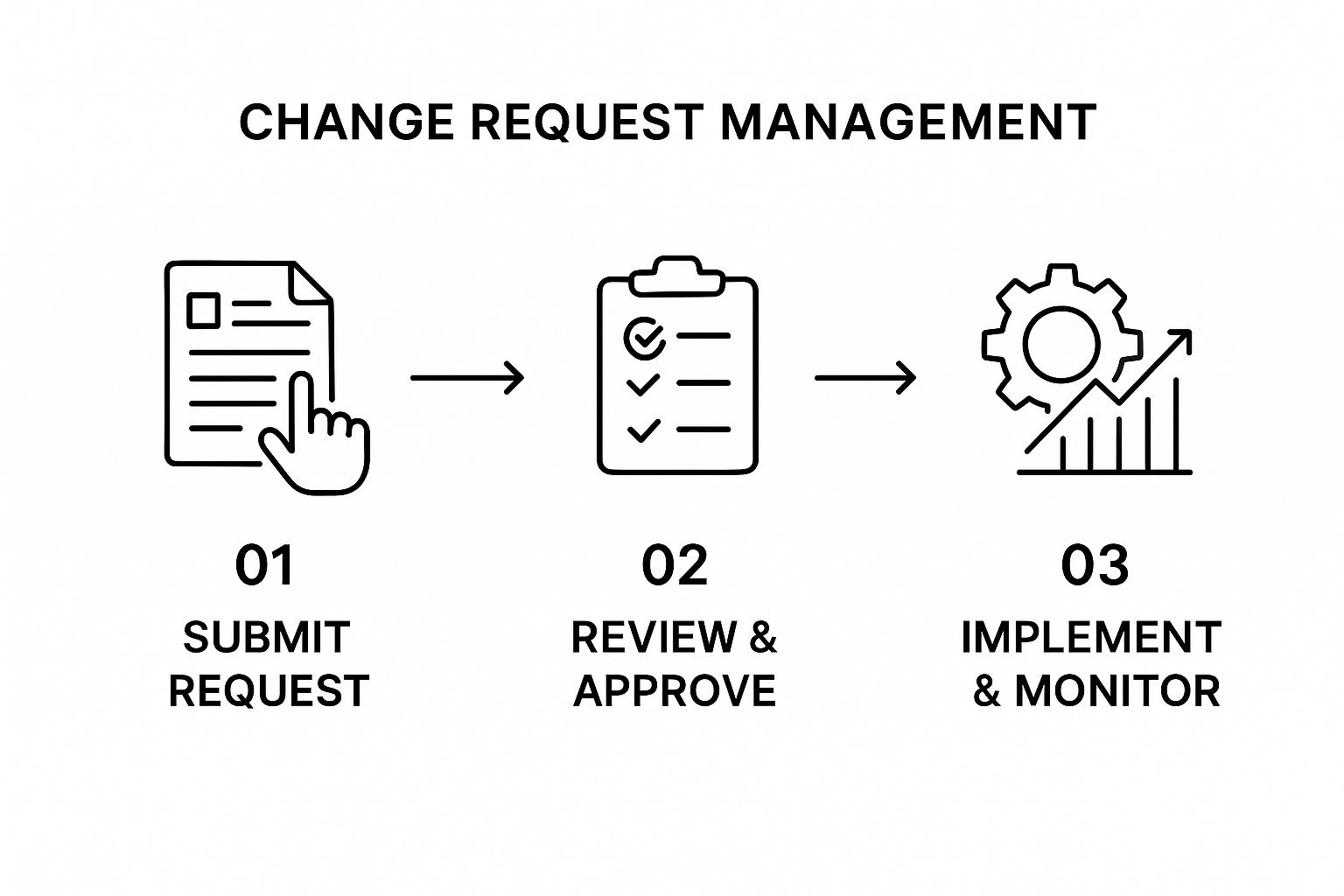Ever had that sinking feeling when a client asks for a "small tweak" and you just know it's the start of a project-derailing avalanche? You're not alone. But here's the quick win: you can stop the chaos before it starts with a simple, formal process.
Establishing a clear change request management system isn't about adding bureaucracy. It’s about creating a single, official "front door" for all new ideas. This one step forces everyone to pause, think, and make conscious decisions, turning potential disasters into manageable, profitable opportunities.

What Is Change Request Management, Really?
Think of your initial project plan as a roadmap. But what happens when a client wants to take an unexpected, scenic detour? Instead of just yanking the wheel, change request management is the process of pulling over, looking at the map together, and agreeing on the new route—before you burn through your gas (budget) and miss your arrival time (deadline).
It's a formal, actionable way to handle those "hey, could we just..." moments that can quietly derail an entire project. This process turns potential chaos into a controlled, conscious decision, protecting both your team and your client from nasty surprises down the road.
Mini Case Study: The Web Agency Pivot
Let's make this tangible. A web agency is in the middle of building a new site for a client. Suddenly, the client sees a competitor's site and decides they need a fancy, animated video header.
Instead of the project manager immediately saying "sure, we can do that!" and scrambling behind the scenes, they use their change request process.
- Intake: The PM asks the client to submit the idea through their simple change request form in the client portal.
- Assessment: The team calculates it will add 25 hours of development and design time, pushing the launch back by four days.
- Approval: The project manager presents a simple impact report to the client showing the new cost and revised timeline.
Faced with clear data, the client understood the trade-offs and happily approved the updated budget and schedule. A situation that could have easily become a point of contention was smoothly converted into a paid add-on, all thanks to a simple process.
The 5-Step Change Request Management Process
We've all been there—that sinking feeling when a project you're managing starts to veer off track. A client mentions a "small tweak" in a meeting, an idea pops up in an email, and before you know it, you're dealing with scope creep. Instead of scrambling every time a client has a new idea, this proven, five-step process gives you a reliable roadmap.
Step 1: Submission
First, you need a single, official front door for all change requests. Your mission here is to create a straightforward, easy-to-use change request form. This simple act eliminates so much confusion and ensures every single request is captured with all the necessary details right from the start.
This form is the one and only way a change can be formally proposed—whether it's from your team or the client. Using a client portal tool like growlio makes this incredibly clean and professional, keeping everything centralized and easy to track.

A well-designed form gently forces the person making the request to think through their idea. Make sure it includes these essentials:
- Clear Description: What, exactly, is the proposed change?
- Business Justification: Why is this change needed? What problem will it solve?
- Priority Level: How urgent is this? (e.g., High, Medium, Low).
This first step isn't about putting up roadblocks. It’s about gathering high-quality information so you can make smart decisions down the line.
Step 2: Evaluation
Once a request is officially submitted, it’s time to figure out what it really means for the project. The project manager or a designated lead translates the request into concrete data.
Your evaluation needs to hit three critical areas:
- Scope Impact: How does this new idea fit with the project's original goals? Does it change our deliverables?
- Timeline Impact: How many extra hours or days will this actually take? Will it push back the final deadline?
- Budget Impact: What's the bottom line? What are the additional costs for labor, tools, or other resources?
A thorough evaluation shifts the conversation from a vague "Can we do this?" to a clear "Here is what it would take to get this done." For more complex requests, it helps to use different project estimation techniques to make sure your assessment is accurate.
Step 3: Approval
With a detailed impact assessment in hand, it's time to get a formal sign-off. This usually means presenting your findings to the key decision-makers, which almost always includes the client and any important internal leaders.
The goal here is total transparency. You lay out the data from your evaluation and clearly explain the trade-offs. For instance: "We can absolutely add that e-commerce feature. Our analysis shows it will require an additional 40 hours of development, which extends the project timeline by two weeks and adds $X to the total budget."
This structured approach allows stakeholders to make a business decision based on facts, not feelings. Their decision—whether to approve, reject, or put the request on hold—should then be formally documented.
Step 4: Implementation
Once a change gets the green light, it needs to be carefully woven into the existing project plan. This is a crucial step that many people miss. You can't just tack it on; you have to merge it intelligently.
This means updating your task lists, re-assigning resources where needed, and officially adjusting the project schedule in your management tool. The approved change request now becomes part of the new, official project baseline. In an agile setup, this might look like adding the new work as a story to the backlog, ready to be prioritized in an upcoming sprint.
Step 5: Communication
The final—and ongoing—step is to communicate the decision and the updated plan to everyone. Every team member, every stakeholder, and every client contact needs to be on the same page about the approved change and what it means for the project moving forward.
This infographic gives a great overview of the entire flow.

As the visual shows, a successful process hinges on a clear progression from submission all the way to monitoring. When you follow the steps, you ensure the project team is always working from the latest plan and the client's expectations are properly managed, preventing costly misunderstandings down the road.
How to Handle Scope Creep Without Derailing Your Project
Have you ever been deep into a project when the client hits you with a "small" change? That one little request can quickly strain the relationship, making you feel like you're suddenly in a high-stakes negotiation instead of a partnership. The trick isn't to shut down change, but to master the conversation around it.
It's easy to fall into traps like miscommunication or, even worse, just saying "yes" without thinking through the real consequences. This is where most projects go off the rails. In fact, studies show that a staggering 70% of change initiatives fail, not because the new ideas are bad, but because the process for handling them is broken.
Having a structured process in place is your secret weapon. It takes the emotion out of the discussion and frames it around objective facts that you and your client can look at together.
Mini-Case Study: The "Pixel Perfect" Pivot
Let's walk through a real-world example. Imagine Pixel Perfect, a web design agency, is two months into a three-month project building an analytics dashboard for their client. The scope is clear, the team is hitting its deadlines, and everything is humming along nicely.
Suddenly, the client hires a new Head of Sales who wants to completely pivot. He envisions the dashboard including a whole suite of internal sales metrics—a massive change from the original, client-facing tool.
Instead of hitting the panic button, the project manager at Pixel Perfect took a deep breath and did three things right:
- She Communicated Immediately: She first acknowledged the request with genuine enthusiasm, framing it as a valuable idea. Then, she set clear expectations: "This sounds like a great evolution for the tool. To make sure we get it right without derailing our current progress, our standard process is to put together a quick impact report outlining what it would take to build this new feature set."
- She Delivered a Detailed Impact Report: The team didn't just wing it. They did the work to calculate the exact number of extra development hours needed, the cost of new software licenses, and the impact on the final delivery date. They presented this not as a roadblock, but as a clear, easy-to-digest document.
- She Facilitated a Collaborative Decision: With the report in hand, she scheduled a meeting. The conversation was no longer, "Can you do this for us?" It became, "Here are two paths to get you to your new goal, along with the updated budget and timeline for each. Which option works best for you right now?"
By leaning on their change request management process, Pixel Perfect turned a potential disaster into a win-win. The client felt understood and empowered, and he happily approved the budget increase and new timeline. This didn't just save the project; it proved the agency was a strategic partner, not just a team of coders.

The most important part of this diagram is that "transition state" in the middle. That's where projects fall apart and relationships get stressed. A good process helps you manage that transition deliberately, preventing it from spiraling into chaos. If you're looking for more strategies to keep clients and projects aligned, our guide on how to manage client expectations is a great place to start.
Advanced Tips for Effective Change Management
Ever get that sinking feeling when a simple, two-hour fix has to go through the exact same lengthy approval process as a two-week project overhaul? If so, you're not just wasting time—you're creating a bottleneck that frustrates your team and slows down real progress. The good news is, there's a better way.
The key is to evolve your change request process from a rigid gatekeeper into a smart, flexible system. By creating a fast lane for low-impact adjustments, you empower your team to be more agile. This also frees up key decision-makers to focus their energy on the major changes that genuinely steer the project's direction.

Establish Smart Thresholds
Let's be honest: not all changes are created equal. One of the most powerful adjustments you can make to your workflow is setting predefined thresholds for what needs a full, formal review. Think of it as an express checkout lane for small requests.
Here’s a practical example: you could set a rule that any change requiring less than four hours of work and no budget increase can be approved directly by the project manager. This small tweak empowers your PM to handle minor issues on the fly, keeping the project humming along. Anything bigger than that? It automatically gets routed through the formal, multi-stakeholder approval process.
Use Analytics to See Around the Corner
Every change request you receive is a piece of a larger puzzle. Instead of just reacting to them one by one, start looking for patterns. Are clients constantly asking for a specific feature you didn't include in the initial scope? That’s not a nuisance; it's valuable business intelligence.
By digging into this data, you can start making smarter decisions:
- Refine future proposals: If a particular add-on is a frequent request, maybe it’s time to build it into your standard service package or offer it as a clear, optional tier from the start.
- Improve resource planning: Noticing trends helps you predict which skills and team members will be in high demand, allowing you to allocate resources more effectively.
- Boost project quality: Recurring issues often point to a weakness in your initial discovery or planning process. This connection is explored more deeply in our guide to project quality management.
This data-driven mindset is at the heart of modern change management. In fact, the latest industry reports from Prosci show a significant trend toward integrating analytics and agile methods to make the entire process more strategic. You can read more about these evolving practices on prosci.com.
Pro Tip: Establish a Change Control Board (CCB)
For your larger, more complex projects, a Change Control Board (CCB) can be a game-changer. This is a dedicated group of stakeholders—often the project manager, a key client decision-maker, and a technical lead—who are formally tasked with reviewing and ruling on major change requests.
When it comes to significant changes, the CCB has the final say. This formal structure eliminates ambiguity and prevents any single person from making a unilateral decision that could derail the project. It ensures high-stakes choices are made with full visibility and collective agreement.
Got Questions About Change Management? We've Got Answers
Even with the best system on paper, you'll inevitably run into some tricky situations once you start managing change requests in the real world. Let's walk through some of the most common questions that pop up and how to handle them.
How Do You Handle Urgent Change Requests?
When an emergency request hits your desk, you need a pre-approved fast-track process. This usually means getting the key decision-makers on a quick call—think project leads and client sponsors—for an immediate verbal "yes" or "no."
The goal here is to balance speed with control. You make the call fast, but you immediately follow it up with the formal change request paperwork. This ensures the decision, its reasoning, and its impact are all documented, leaving no room for confusion later.
What Is the Best Way to Say No?
The trick is to never just say "no." Your impact assessment is your best friend here. Use it to clearly explain the "why" behind the decision, laying out the concrete consequences for the project's budget, timeline, or key objectives.
For instance, you could say: “After looking at this, we found that making this change now would push our launch date back by two weeks. Would you be open to saving this for a Phase 2 release, or could we scope out a smaller version that keeps us on schedule?” This reframes a potential conflict as a collaborative, strategic conversation.
Should We Charge for Analyzing a Change?
This is something you absolutely need to define upfront in your contract or statement of work. A great best practice is to include a clause that allows you to bill for analyzing any complex change that takes up a significant amount of time (say, more than one hour).
This simple step does two things: it encourages clients to think through their requests more carefully, and it ensures you're compensated for the valuable strategic work that goes into a proper assessment.
This positions the analysis as a valuable service in its own right, not just an administrative hoop to jump through. It respects your team’s time and reinforces that every change has a real cost.
Start Managing Project Change Effectively Today
Project change is inevitable. But whether that change leads to chaos or controlled progress is entirely up to you. A solid change request management process is your best defense against the scope creep that eats away at profits and timelines. It's what separates the pros who stay in control from the teams constantly putting out fires.
You have the actionable, step-by-step blueprint. Now, it's about putting that knowledge into practice and building a system that actually works for you and your team.
The path is clear. You have the steps, the insights, and the real-world examples. It's time to build a process that protects your projects and your sanity.
Ready to stop reacting and start directing? You can put these principles into action today by creating your own streamlined change management system with a free growlio account and get back in control of your projects.
